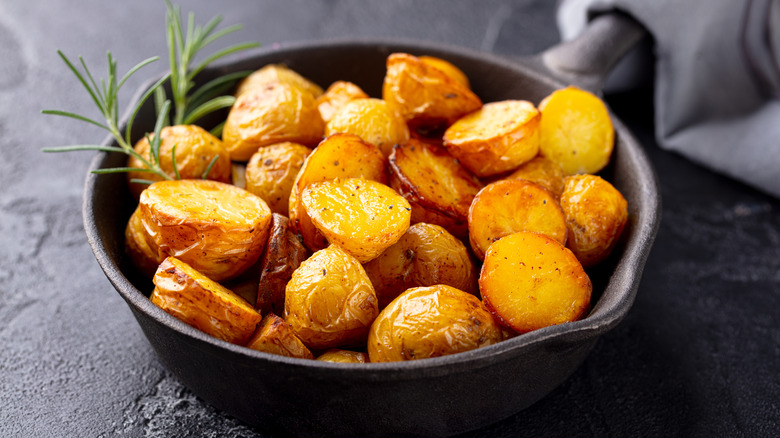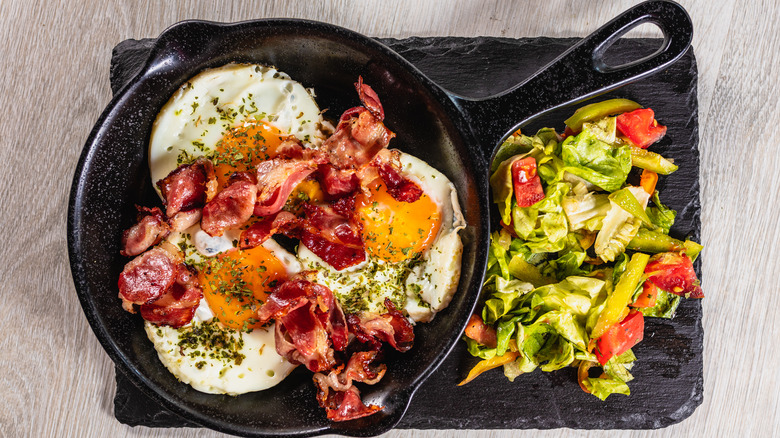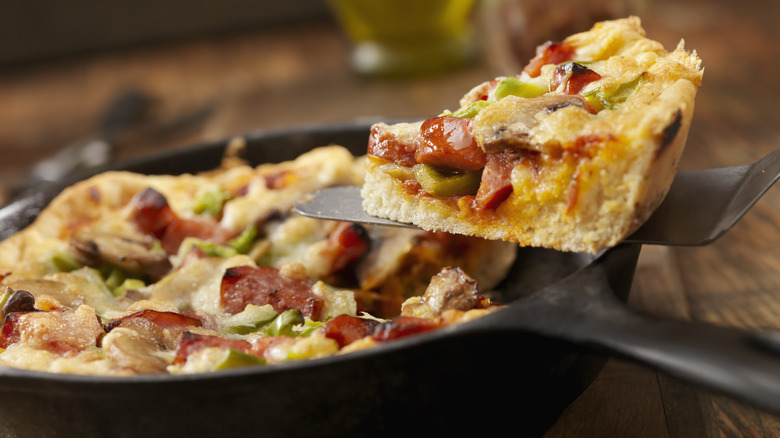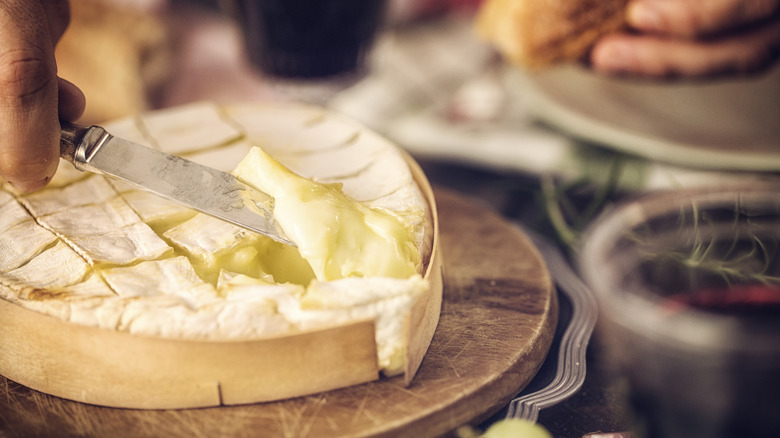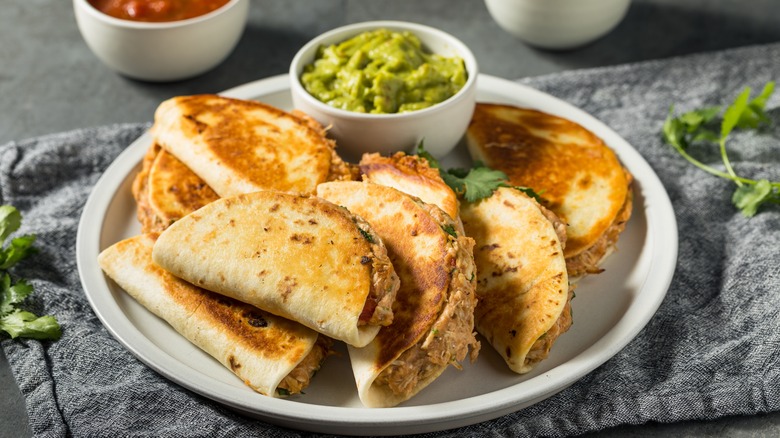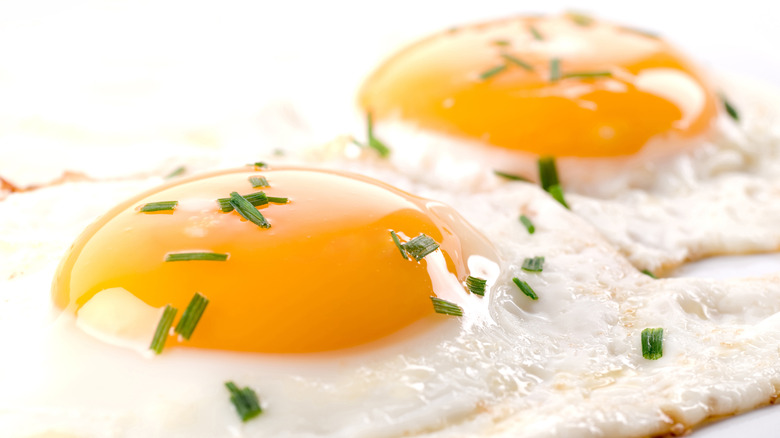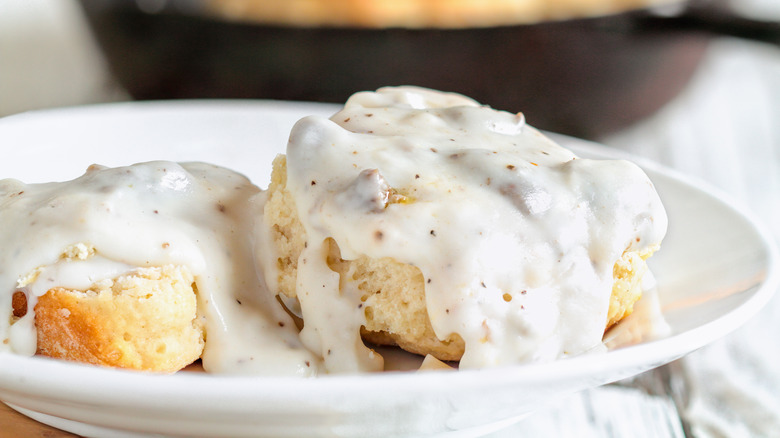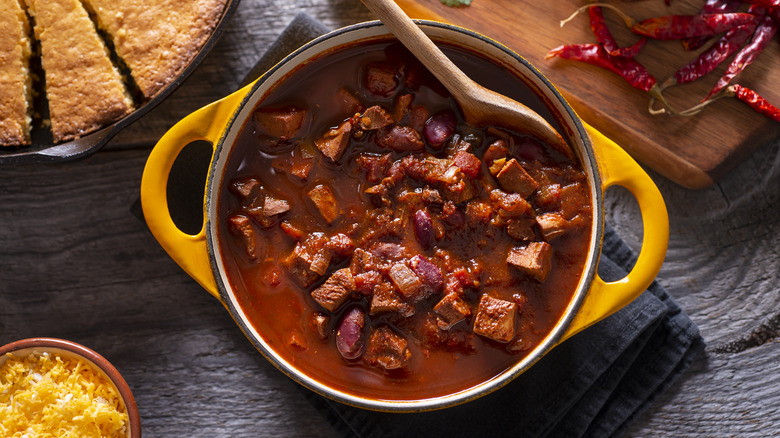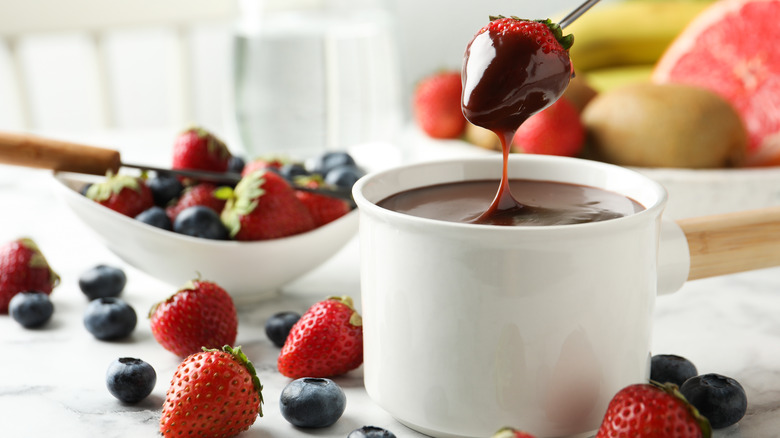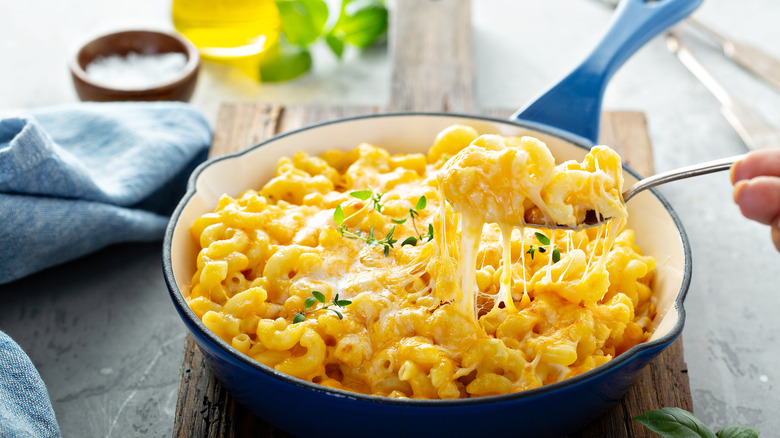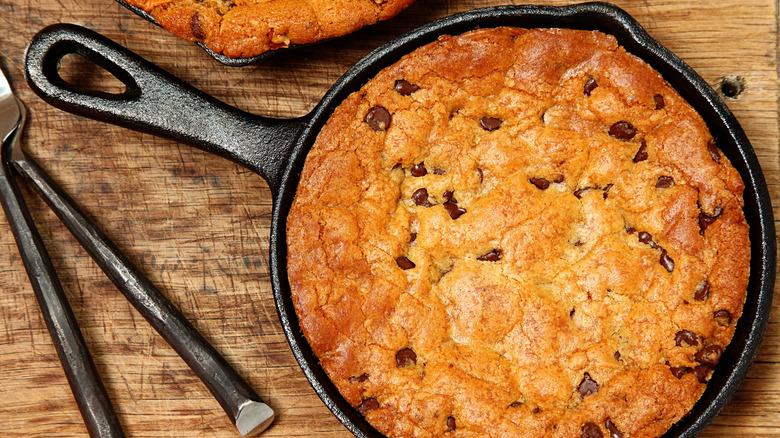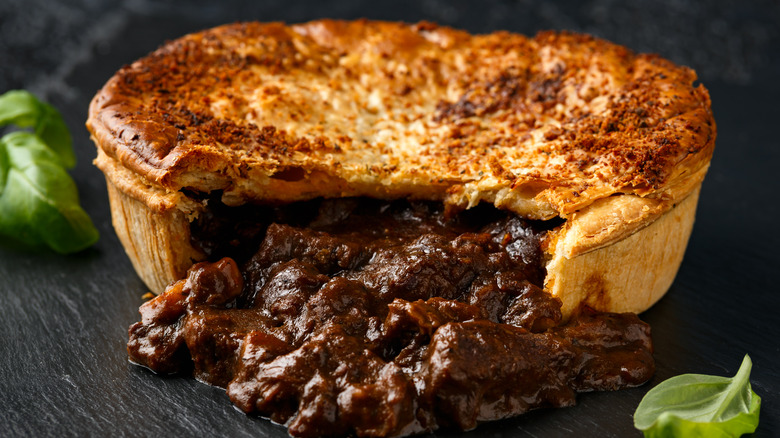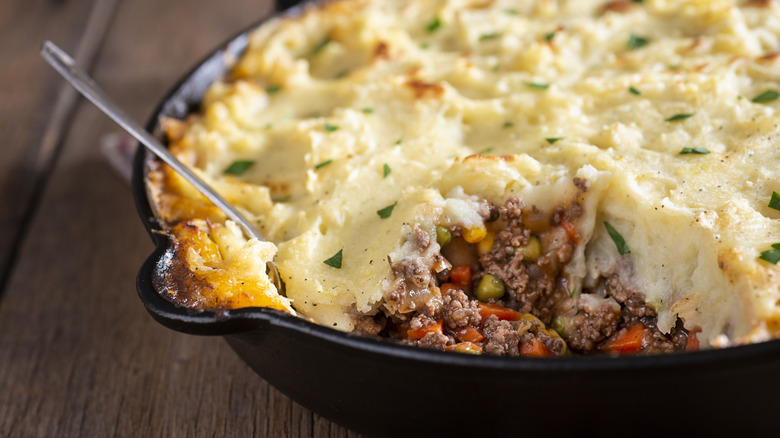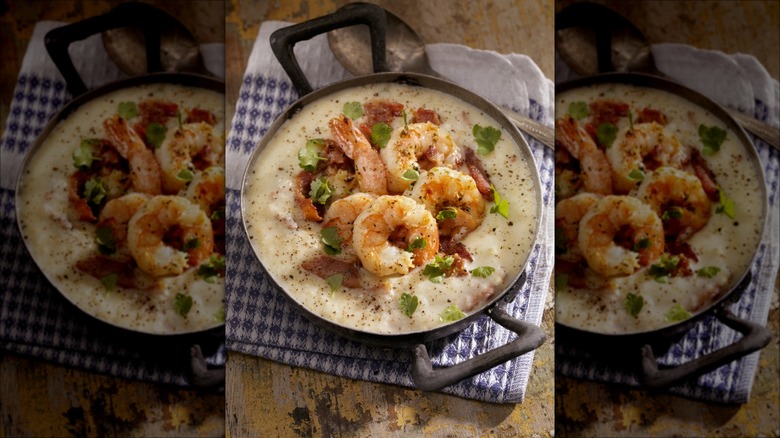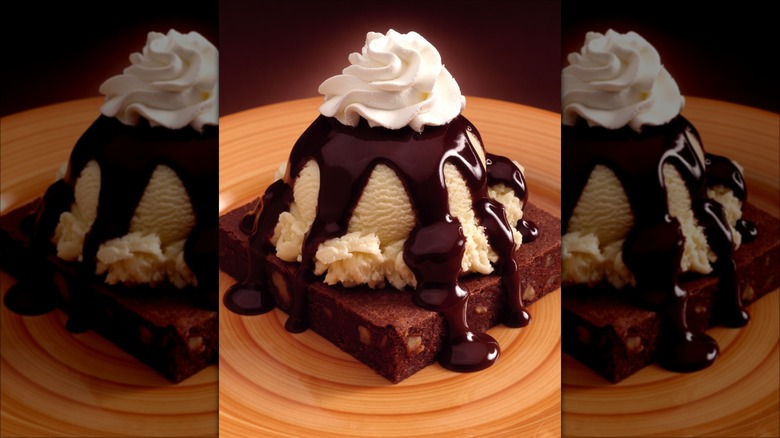15 Ways To Cook With A Mini Cast Iron Skillet
In an era that has embraced the "McBigger" philosophy, it can seem counterintuitive to use a mini cast iron skillet to cook your food. But bigger isn't always better, in life or at the table. While cooking with a larger skillet comes with plenty of advantages — namely, that you have more surface area on which to cook your food — it also comes with some drawbacks. If you have only a small amount of food to cook, you may end up with more evenly cooked food if you use a smaller skillet. A mini cast iron skillet may also produce higher cooking temperatures, which may be ideal for foods that require high heat for searing, like some cuts of steak.
But the benefits of cooking with a mini cast iron skillet go beyond that. Its size and shape make cooking some trickier recipes a bit easier because of the parameters of the pan limit movement, which can be an advantage in some cases. Aside from this, mini cast iron skillets, if used with ingenuity, make setting a rustic table and serving certain styles of food look and feel more authentic. Finally, from a size perspective, there are some storage reasons for keeping mini skillets around. All in all, working with a skillet that measures 6 inches or less can sometimes be a game changer. Here are 15 ideas to get you started, which come from a combination of culinary expertise, practical kitchen applications, and creative adaptation of cooking methods specifically for smaller skillets.
1. Serve mini skillet breakfasts
Conventional wisdom suggests that breakfast should be served on a plate, but if you've ever been to a diner or fast-casual restaurant, then you know that some breakfasts are served in mini cast iron skillets instead of on plates. These breakfasts usually include fixings like fried potatoes, scrambled eggs, sausage links, or bacon bits, plus a multitude of vegetables, including bell peppers and onions. However, a mini skillet also works well when you're serving other breakfast foods, like frittatas or omelets.
From a food quality vantage point, this serving method comes in handy when you want to keep food hot and sizzling. (Think about your last serving of fajitas, and you'll understand what's meant here.) Serving food in the container it was cooked in keeps everything hot, and the construction of the mini skillet allows you to cover food with a lid, keeping it warm until you're ready to eat.
2. Whip up some pan pizzas
Pizza Hut might have popularized pan pizzas, but that hasn't stopped home gourmands from making their own. With a couple of mini cast iron skillets in the pan cupboard, it's possible to avoid the lunch lines at the local pizza restaurant by making your own pan pizza.
Pan pizzas offer a couple of advantages. First, pan pizza recipes work well with recipes calling for a biscuit crust. If you're in a hurry, there's no need to make a time-consuming dough. Just pull out a can of biscuits from the fridge to make the crust, and then add your favorite toppings to it. Second, from a taste and texture perspective, the crust on pizzas cooked in a pan tends to be lighter and fluffier on the inside than some other crusts, while at the same time, having the potential for a crisp crust on the outside. If that's your jam, cooking your pizza in a fun-sized skillet does some of the work for you.
3. Create a baked cheese party appetizer
Baked cheese as an appetizer is a lot of things. Comforting. Delishious. Versatile and easy. Because it's simple to make and easy to tailor to the tastes of your party guests, it's a party appetizer no-brainer, particularly if you bake and serve it in a mini skillet. Cooking is simplified, as is clean-up when you go this route. Which cheese you use will depend on both taste and budget. Certain cheeses, like Brie and Camembert, often find themselves in the middle of a baked cheese platter, flanked with crackers, crusts of bread, and jalapeño jelly. However, other cheeses, like cheddar, also work just as well and offer different flavor profiles to the appetizer course.
Making it can be a simple affair, too, with some recipes calling only for a splash of olive oil in the bottom of the pan — your mini skillet, in this case — and some sliced cheese thrown in on top. If you're really feeling adventurous, try sprinkling in a bit of garlic or dried onions into the mix to give your cheese a savory flavor.
4. Throw together a quesadilla for one
Quesadillas make for a quick and easy meal, and cooking them in a mini cast iron skillet brings with it a number of advantages over cooking the 'dillas in one of the skillet's larger counterparts. First, it's convenient if you want to cook smaller tortilla sizes. No reason to bring out a big, heavy skillet to do a small job.
Second, in terms of cooking space and pan size, you can't go wrong with your fun-sized pan if you're baking quesadillas in something small, like a toaster oven. A toaster oven that'll cook a 12-inch pizza can accommodate the smaller size of the 6- or even 8-inch mini skillet. This cooking method offers more uniform cooking for the quesadilla, and the combination of the toaster oven and small skillet means that your quesadillas are crisp instead of soggy as they would be if you cooked them in a microwave.
5. Fry up some eggs for two
Anyone who has ever tried to fry eggs knows what a precarious bit of business this can be. In a large pan, the whites of the eggs tend to expand over the bottom surface of the skillet, making it difficult to create rounder, more compact, and more uniform-looking eggs. In turn, it's more difficult to take the eggs out of the pan without breaking at least the whites, if not the yolks, too, due to the expansive size of the egg whites.
Frying your eggs in a mini cast iron skillet does away with many of the issues that arise from cooking eggs in a larger-sized pan. A 6-inch skillet confines the contents of the two eggs within the space of the 6 inches. The whites can't spread beyond that. Because of this, the eggs should set up quickly, allowing you to turn them over with ease because you're not forced to wrangle with thin, expansive egg whites. Finally, topping the skillet with a lid after cooking the eggs for a couple of minutes on medium heat allows you to fry the eggs without burning them.
6. Store in your camper
Cooking, and of equal importance, storing cooking supplies, in a small space is a challenge that RVers face. Cooking tools, like your mini skillet, offer you both functionality and practicality. From a cooking perspective, other than being smaller, your tiny pan works in the same way as a larger one would, though you may have to cook less at one time than you would otherwise. Reducing the size of the tools to cook with goes a long way toward allowing you to function normally in a small space. Most RVs have limited storage space. These storage compartments often exist above the head in the kitchen/living area of the RV and are often no bigger than your average toaster oven. With van living, storage space is even tighter.
And that doesn't even cover all the times when you may be forced to live small when you're not out on the road. Living in a college dorm or in one of those micro apartments that have become popular in recent years are examples. With a diameter of only 3 to 6 inches, your tiny skillet fits in your tiny house just as well as it would in an RV, without forcing you to spend less time cooking at home and more time in restaurants due to lack of space.
7. Make biscuits and gravy
Your mini cast iron skillet, a can of biscuit dough in the fridge, and a few minutes on Sunday morning may be all that stands between you and a plate of piping hot biscuits and gravy for one. For those who bake biscuits and gravy on the regular, it's not unusual to bake them in a larger skillet. Often, this skillet of morning goodness is earmarked for a larger group of three to four people.
However, from a portion standpoint, you get the same meal from your mini skillet and a few doughy biscuits stolen from the can of biscuit dough you bought at the grocery store, which means a hardy breakfast is open to you, even if you're missing a couple of people at the table. At least three regular-sized biscuits should fit into the pan. Once they're done baking, serve the biscuits in the pan instead of on a plate to save yourself some dishes. Fill the biscuits with butter and jam on light cooking days. Or whip up some country gravy for the full meal deal.
8. Bake some cornbread for chili
Count dishes like chili and cornbread among the great party recipes for events like the Super Bowl or a fall family get-together. Baking individual-sized cornbread servings in mini cast iron skillets offers a fun way to serve this party staple food with your favorite chili recipe. Keeping the cornbread in the skillets ensures that your guests' cornbread stays warm as they make their way through the chili bar.
To protect your table from the hot pans, set the table with individual hot pads made of thick cotton or corkboard, taking care to place one at each place setting. When you serve the skillets of cornbread, have some additional hot pads on hand for the handles of the pans, so that guests can help themselves to their cornbread without toasting their fingers.
9. Heat up a small serving of chocolate fondue
Chocolate fondue is a great treat for chocolate lovers, but some may avoid making it due to the perception that it's complicated to make. While some occasions call a bonafide fondue maker, it isn't always necessary to go to such lengths to melt the chocolate.
For this, you just need your mini skillet. A simple chocolate fondue recipe consists of a bit of cream, a pinch of salt, and of course, chocolate. These ingredients form the base for a sweet sauce to dip fruits, like bananas, apples, orange slices, or even savory foods, like pretzels. If you're concerned about the chocolate cooling down before dessert is done, you have the option of popping the pan back on the stove for a few. Or plug in a breakfast maker with a grill and set it on a low temperature to keep the chocolate warm right at the table.
10. Bake mac and cheese for one
Baked mac and cheese with its ooey, gooey blend of cheeses, crunchy sprinkles of seasoned bread crumbs, and warm-your-tummy comfort naturally lends itself to the skillet-meal treatment. For starters, one of the elements that makes the dish so irresistible is the melted cheese. Baking it and then serving it in the mini cast iron skillet you made it in keeps the cheeses warmer for longer because the cast iron is a natural heat conductor.
Secondly, if you're interested in trying something a little different, the mini skillet is your go-to tool for this. For example, if you've ever wanted to try a mac and cheese recipe that doesn't require you to boil the noodles in water before you bake the mac and cheese, attempting the dish in your mini skillet first can help you work out the kinks before trying to make the dish on a larger scale. If your efforts don't work out the way you wanted, you haven't wasted a whole pan of mac and cheese. If they do, you have a delish dinner as a reward.
11. Treat yourself to a giant chocolate chip cookie
A 6-inch mini skillet provides you with the perfect baking pan for a single, large chocolate chip cookie. If you're the type that keeps refrigerated cookie dough in your apartment at all times, going this route allows you to treat yourself to a cookie without having to make a whole batch of cookies. Follow the cooking directions on the package, though there's a caveat to keep in mind. It can take some time for your cast iron to fully heat up, so to ensure a more evenly baked cookie, try heating the skillet up for a few minutes in the oven before dropping the cookie dough in.
The cookie will come out the other side with just the right amount of crispiness on the outside and chewy, chocolatey goodness on the inside. Baking a cookie this way is an easy way to make giant chocolate chip cookies that won't lose their shape as they bake. The sides of the mini skillet keep the cookie nice and round.
12. Warm up your tummy with pot pie for one
Single servings of pot pie in restaurants often come to the table in the dish they were baked in. Take a hint from your favorite restaurant and make a personal pot pie using your mini skillet. The mini skillet is about the same size as many baking dishes that cooks use to make individual-sized pot pies, which makes it a viable substitute for a small baking dish.
As far as crusts are concerned, you have a couple of options that should bake up nicely in the skillet. Try your favorite pie crust recipe — or a quality store brand in a pinch — or go with a biscuit crust for a "breadier," softer pie crust. If you go the biscuit route, it isn't necessary to encase the vegetables and meat inside a pocket unless you want to. Topping the pie with a bread crust is often enough to give you something to soak the juices up with without making the dish all dough and nothing else.
13. Treat yourself to shepherd's pie
If ever you'd like to sit down to a taste of Irish history, just whip up a bit of shepherd's pie in your mini cast iron skillet. Like other famous Irish dishes, such as colcannon, the dish includes plenty of mashed potatoes and, occasionally, cabbage nestled in savory juices where some additional veggies, like carrots, peas, mushrooms, and ground beef cool and steam to stewy perfection. It's this type of dish that people serve at St. Patrick's Day celebrations, and adding your mini skillets to the mix means that you can make individual shepherd's pies for all of your St. Patty's Day guests.
To make this dish in miniature, you'll prep everything ahead of time in a larger skillet, cooking the veggies and beef together. In a separate pot, boil the potatoes to get them ready for mashing. Once the stew and the potatoes are done, transfer them into individual mini skillets, filling each skillet first with the stew and then topping it with a layer of potatoes and cheese if you desire. Bake the shepherd's pies until the potatoes and cheese are a bit crusty.
14. Cook up shrimp and grits for brunch
Who knew that dried ground corn could taste so delishious? If you've ever eaten grits, then you know what a treat this cereal-ish version of corn is in the morning. Over the centuries since they were first introduced by Native American tribes in the 16th century, people have tossed in ingredients like mushrooms, cheese, fresh corn, hot peppers, and more to make this morning delicacy.
The addition of shrimp to a grits recipe elevates the dish to a bonafide brunch-with-friends recipe. To prepare it, put your mini skillets in the oven on low heat to warm them up. On the stovetop, prepare the grits according to the package instructions. On the side, sautée together the shrimp, and other ingredients, like mushrooms and onions. Remove the mini skillets from the oven and ladle in servings of grits topped with shrimp, mushrooms, and green onions for garnishes. Serve the grits in the skillets on a hot pad.
15. Baking up brownies is easier
The first brownie recipe appeared in a cookbook by Fannie Farmer in the late 1800s. This hard-to-classify dessert isn't exactly a cookie, nor is it a cake, but somewhere in between, a finger food of sorts that's impossible to put down once you get your fingers on a few. To complicate matters further, and to make them more delightful, not all brownies are chocolate only. Some come with caramel, peanut butter, or vanilla swirls mixed in.
Making the challenge of keeping your fingers off all the more difficult are inventions like brownie mix and mini skillets that allow you to make just one very large brownie at a time. One standard box will make about two large skillet brownies if you use small 3.5-inch skillets. A 6- or 8-inch skillet will fit about two with some leftover mix. You may have to experiment a bit to find the right ratio. Top finished brownies with ice cream, chocolate syrup, and nuts.
